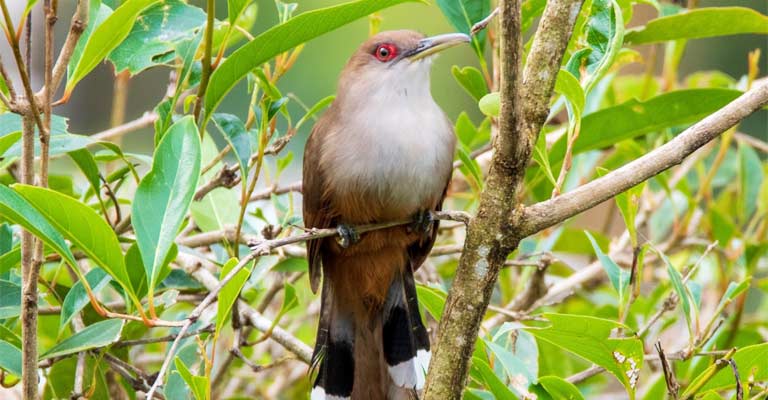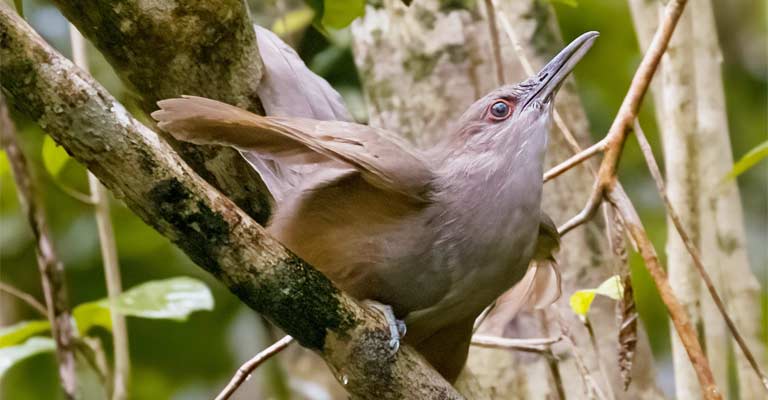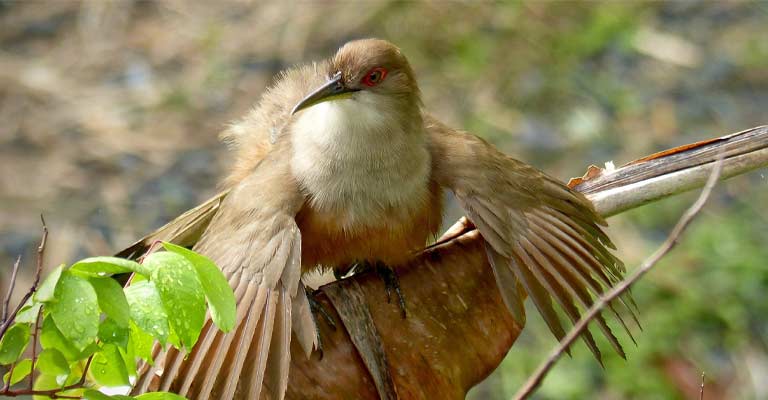The Puerto Rican Lizard Cuckoo, scientifically known as Coccyzus vieilloti, is a captivating avian species endemic to the lush landscapes of Puerto Rico.
Renowned for its distinctive appearance and mesmerizing vocalizations, this medium-sized bird has become a symbol of the island’s rich biodiversity.
With its slender body, long tail, and striking plumage, the Puerto Rican Lizard Cuckoo stands as a testament to nature’s artistry. Its predominantly brown and white feathers are adorned with subtle patterns, showcasing a harmonious blend of colors.
Beyond its visual allure, this cuckoo is celebrated for its unique call, a melodic and echoing series of coos that resonates through the tropical forests it inhabits.
As a vital component of Puerto Rico’s ecosystems, the Lizard Cuckoo plays a crucial role in maintaining ecological balance by controlling insect populations.
Through its enchanting presence and ecological significance, the Puerto Rican Lizard Cuckoo captures the essence of the island’s avian wonders.

Physical Characteristics of Puerto Rican Lizard Cuckoo
The Puerto Rican Lizard Cuckoo (Coccyzus vieilloti) possesses distinctive physical characteristics that make it easily identifiable in its native habitat.
Understanding these key features is essential for bird enthusiasts and researchers alike.
Size and Shape

The Lizard Cuckoo is a medium-sized bird with a length ranging from 11 to 13 inches (28 to 33 cm).
Its slender body is complemented by a long tail, making up a significant portion of its overall length. The bird’s physique, while agile, exhibits a balanced and streamlined profile.
Plumage Coloration
The plumage of the Puerto Rican Lizard Cuckoo is characterized by a harmonious blend of earthy tones.
The upperparts are primarily brown, while the underparts are adorned with a contrasting white color. This color scheme contributes to the bird’s overall understated yet elegant appearance.
Distinctive Head Markings

The head of the Lizard Cuckoo features striking markings, including a bold black line running through its eye and extending behind it.
This eye stripe adds a defining element to the bird’s facial characteristics, making it a key feature for identification.
Long Bill
A notable physical trait of the Puerto Rican Lizard Cuckoo is its long, slightly curved bill. This adaptation is well-suited for capturing its preferred prey, which often includes insects and small reptiles.
The bill’s length is proportional to the bird’s body size, contributing to its overall balanced appearance.
White Tips on Tail Feathers

The tail feathers of the Lizard Cuckoo are noteworthy for their distinct pattern. The outer tail feathers often feature white tips, creating a subtle yet eye-catching display when the bird is in flight or perched in its natural habitat.
Slender Neck and Body
This cuckoo species exhibits a slender neck that seamlessly connects to its body, enhancing its overall agility. The streamlined physique enables the bird to navigate through the dense vegetation of Puerto Rican forests with ease.
Long Legs and Feet

The Puerto Rican Lizard Cuckoo is equipped with long legs and feet, well-adapted for perching and moving within the varied terrain of its habitat. These features contribute to its versatility in both ground-level foraging and elevated perching.
Melodic Vocalizations
While not a physical characteristic, the bird’s vocalizations are distinctive and aid in identification. The Lizard Cuckoo produces a series of melodious coos that resonate through the forest, adding an auditory element to its presence.
The Puerto Rican Lizard Cuckoo’s physical characteristics, ranging from its size and plumage to distinctive markings and vocalizations, collectively create a unique and easily recognizable profile for enthusiasts and researchers observing these birds in their natural environment.
Taxonomy of Puerto Rican Lizard Cuckoo

The table below will tell you everything about the taxonomy details of the Puerto Rican Lizard Cuckoo:
| Taxonomic Rank | Classification |
| Domain | Eukaryota |
| Kingdom | Animalia |
| Phylum | Chordata |
| Class | Aves |
| Order | Cuculiformes |
| Family | Cuculidae |
| Genus | Coccyzus |
| Species | C. vieilloti |
The Puerto Rican Lizard Cuckoo (Coccyzus vieilloti) belongs to the Cuculidae family, which encompasses a diverse group of medium to large-sized cuckoos.
As a species endemic to Puerto Rico, it falls within the Coccyzus genus, characterized by long tails and a preference for wooded habitats. The specific epithet “vieilloti” honors the French naturalist Louis Jean Pierre Vieillot.
This bird is part of the broader avian order Cuculiformes, which includes a variety of cuckoos, anis, and roadrunners. The taxonomic classification underscores the Lizard Cuckoo’s place within the rich tapestry of avian biodiversity.
Hunting Habit of Puerto Rican Lizard Cuckoo

The Puerto Rican Lizard Cuckoo (Coccyzus vieilloti) exhibits a hunting habit marked by a diverse diet and strategic foraging techniques.
Primarily insectivorous, it preys on insects such as beetles, caterpillars, and grasshoppers, showcasing adaptability in its feeding preferences.
The long, slightly curved bill aids in capturing both aerial and ground-dwelling prey. With agile flight and a slender physique, the bird adeptly navigates the dense vegetation of Puerto Rican forests, actively pursuing its prey.
The Lizard Cuckoo is also known to consume small reptiles and amphibians, further showcasing its versatility in hunting strategies. While it typically hunts alone, these cuckoos may occasionally be observed in pairs or family groups.
Their foraging behavior, combined with a melodious vocalization that can attract insects, highlights the multifaceted nature of the Puerto Rican Lizard Cuckoo’s hunting habits within the island’s unique ecological landscape.
Puerto Rican Lizard Cuckoo Life History
The life history of the Puerto Rican Lizard Cuckoo (Coccyzus vieilloti) is a captivating narrative woven into the rich tapestry of Puerto Rico’s diverse ecosystems.
From its dietary preferences to breeding habits and the challenges it faces, this avian species unfolds a story that reflects its integral role in the island’s ecological balance.
Food

The Lizard Cuckoo is predominantly insectivorous, feasting on a varied diet that includes beetles, caterpillars, grasshoppers, and other small invertebrates.
Its long, slightly curved bill is a specialized tool for capturing prey, showcasing adaptability in its foraging strategies. The bird’s agile flight and slender physique enable it to navigate dense vegetation in search of its next meal.
Habitat
This species thrives in Puerto Rico’s tropical and subtropical forests, favoring the diverse landscapes ranging from lowland areas to higher elevations.
Its habitat choice reflects a preference for wooded environments where it can efficiently hunt, perch, and reproduce.
Range Map
The range map of the Puerto Rican Lizard Cuckoo encompasses the entire island of Puerto Rico.
From the dense forests of El Yunque National Forest to the coastal woodlands, the bird’s distribution highlights its adaptability to various ecological niches within the island.
Breeding

Breeding in the Lizard Cuckoo typically occurs during the island’s wet season, from March to August. The species is known for its monogamous mating habits, with pairs collaborating to build nests in trees.
The female lays a clutch of eggs, and both parents contribute to the incubation and care of the offspring, showcasing a cooperative breeding strategy.
Diseases
While specific diseases affecting the Puerto Rican Lizard Cuckoo may not be extensively documented, as with many avian species, it may face threats from habitat loss, climate change, and potential exposure to diseases affecting bird populations globally.
Treatment
Conservation efforts aimed at preserving the bird’s habitat, implementing sustainable forestry practices, and raising awareness about the importance of biodiversity contribute to the overall well-being of the Puerto Rican Lizard Cuckoo.
Additionally, monitoring for potential disease outbreaks and addressing them promptly are crucial components of conservation initiatives.
Conservation

The Puerto Rican Lizard Cuckoo faces challenges typical of island endemics, including habitat fragmentation and degradation.
Conservation measures involve preserving and restoring its natural habitats, implementing sustainable land-use practices, and engaging local communities in conservation awareness programs.
Protecting this species ensures the preservation of Puerto Rico’s unique avian biodiversity and the ecological balance it sustains.
Nesting Habit of Puerto Rican Lizard Cuckoo
The Puerto Rican Lizard Cuckoo exhibits a meticulous nesting habit, constructing platform nests in the forks of tree branches.
Typically composed of twigs and plant materials, the nests are strategically concealed in the dense foliage, protecting the 2-3 smooth, glossy eggs laid by the female.
Both males and females actively participate in nest-building, incubation, and caring for the nestlings. Cooperative breeding is a notable behavior, emphasizing the collaborative effort in raising offspring.
The nesting site, situated at moderate heights in trees, reflects the bird’s adaptation to Puerto Rico’s varied landscapes, ensuring the survival of its species in the island’s lush ecosystems.
Here’s a table outlining the nesting details of the Puerto Rican Lizard Cuckoo:
| Nesting Details | Facts |
| Clutch Size | Typically 2 eggs, occasionally 1 or 3 |
| Number of Broods | Usually 1, but may attempt a second brood |
| Egg Length | Approximately 1.2 – 1.4 inches (3 – 3.5 cm) |
| Egg Width | Approximately 0.9 – 1 inch (2.2 – 2.5 cm) |
| Incubation Period | About 13-14 days |
| Nestling Period | Approximately 13-16 days |
| Egg Description | Smooth, glossy surface; white or pale blue-green with no markings |
| Nest Type | A platform nest made of twigs, placed in the fork of a tree branch |
5 Fun Facts About Puerto Rican Lizard Cuckoo
The Puerto Rican Lizard Cuckoo, Coccyzus vieilloti, a charismatic inhabitant of Puerto Rico’s lush landscapes, boasts intriguing attributes that make it a captivating species to explore.
- Melodious Coos: This cuckoo is renowned for its enchanting vocalizations, a series of melodic coos echoing through the tropical forests, creating an atmospheric symphony distinctive to the island.
- Dietary Diversity: While primarily insectivorous, the Lizard Cuckoo showcases dietary flexibility, occasionally indulging in small reptiles and amphibians, demonstrating its adaptability within Puerto Rico’s ecosystems.
- Monogamous Mates: Exhibiting monogamous mating habits, these cuckoos form enduring pair bonds, collaborating in nest-building, incubation, and the rearing of offspring—a testament to their cooperative breeding strategy.
- Tail Feather Elegance: The bird’s long tail feathers, adorned with white tips, add an elegant touch to its appearance, creating a visually striking display during flight or while perched.
- Habitat Harmony: Thriving in diverse environments, from lowlands to higher elevations, the Lizard Cuckoo symbolizes the harmonious coexistence between its unique adaptations and Puerto Rico’s rich ecological tapestry.
Wrapping Up
The Puerto Rican Lizard Cuckoo emerges as a fascinating avian ambassador of Puerto Rico’s biodiversity. Its slender frame, distinctive plumage, and enchanting vocalizations underscore its vital role in the island’s ecosystems.
From its meticulous nesting habits to cooperative breeding strategies, this species embodies the delicate balance of nature within Puerto Rico’s lush landscapes.
As it faces conservation challenges, understanding and appreciating the unique life history, hunting habits, and nesting behaviors of the Lizard Cuckoo become crucial for fostering a sustainable coexistence between this remarkable bird and its environment.